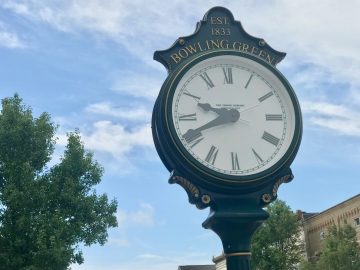BY MEGAN HENRY
The clocks will fall back this weekend, but Ohio lawmakers are urging Congress to get rid of the time change and make daylight saving time permanent.
The Ohio House State and Local Government Committee passed a resolution Tuesday that urges Congress to enact the Sunshine Uniformity Act of 2023, which would permanently switch Ohio to daylight saving time.
House Concurrent Resolution 7, which now goes to the House floor, would not immediately change Ohio clocks. Only federal law could make that change. State Reps. Rodney Creech, R-West Alexandria, and Bob Peterson, R-Sabina introduced the resolution in May.
“We simply no longer need the biannual tradition of changing our clocks,” Creech said in his testimony.
State Reps. Latyna Humprhey, D-Columbus, and Daniel Troy, D-Willowick, voted against the resolution.
Clocks are set for daylight saving time from March to November. Permanent daylight savings would bump the sunrise and sunset back an hour, leading to darker mornings and lighter nights. The proposed resolution would push the sunrise back until almost 9 a.m. and the sunset until after 6 p.m. on the shortest day of the year.
Ohioans simply don’t want to change their clocks, he said when speaking to the Ohio House State and Local Government Committee in May.
“Switching to daylight saving time would increase the hours of sunlight in the evenings year round and could help combat some mental health issues from the darker winter evenings we currently have on standard time,” Creech said. “…When you’ve been at work all day, the last thing you want to do is open that door to go outside and it’s dark out,” Creech said. “It gives a little more daylight at the end of the day.”
Young students walking to school or waiting for the bus in the morning in the dark is a concern with making daylight saving time permanent. But Peterson addressed that issue in his sponsor testimony and suggested school districts adjust their start times during the winter months.
Rep. Marilyn John, R-Richland County, said she was one of the first students on the school bus in the morning.
“It was dark every morning I got on the school bus, so from a safety standpoint I made it all the way through school and we had no issues,” she said.
Standard Time
President of Save Standard Time Jay Pea wants to make standard time permanent, what he refers to as God’s time.
He argues standard time would not improve people’s health and safety, but it would also benefit schoolchildren, farmers and commuters.
“(Daylight saving time) would deprive morning light needed by farmers, construction workers, and other outdoor laborers,” Pea wrote in his testimony. “It would disrupt worship for those who pray daily at sunrise. It would increase the need for morning heat and evening air conditioning in homes.”
History of daylight savings
Daylight saving time started in the United States as a way to save fuel during World War I and a year-round Daylight Saving Time policy was adopted during World War II.
The Uniform Time Act in 1966 requires the country use daylight saving time, but gives states the option to opt out and remain on standard time year-round. Arizona, Hawaii and five U.S. territories have already adopted permanent standard time.
The United States previously tried year-round daylight saving time in 1974 as a way to reduce the country’s energy consumption during the energy crisis, but the switch only lasted eight months before going back to standard time in the fall.
Also from Ohio Capital Journal:
Ohio Democrats are leading vote-by-mail ballots in election on abortion, marijuana
BY MORGAN TRAU/WEWS
Democratic and nonpartisan voters in Ohio are winning the vote-by-mail fight in the November election on abortion and marijuana, an OCJ/WEWS analysis found.
Despite being an off-year, elections workers say early voting numbers are exceeding expectations.
In this election, voters will decide on local issues and candidates, like city council members, and statewide Issue 1 and Issue 2. Issue 1 is the amendment to protect access to abortion and contraception, while Issue 2 would legalize recreational marijuana. READ MORE





